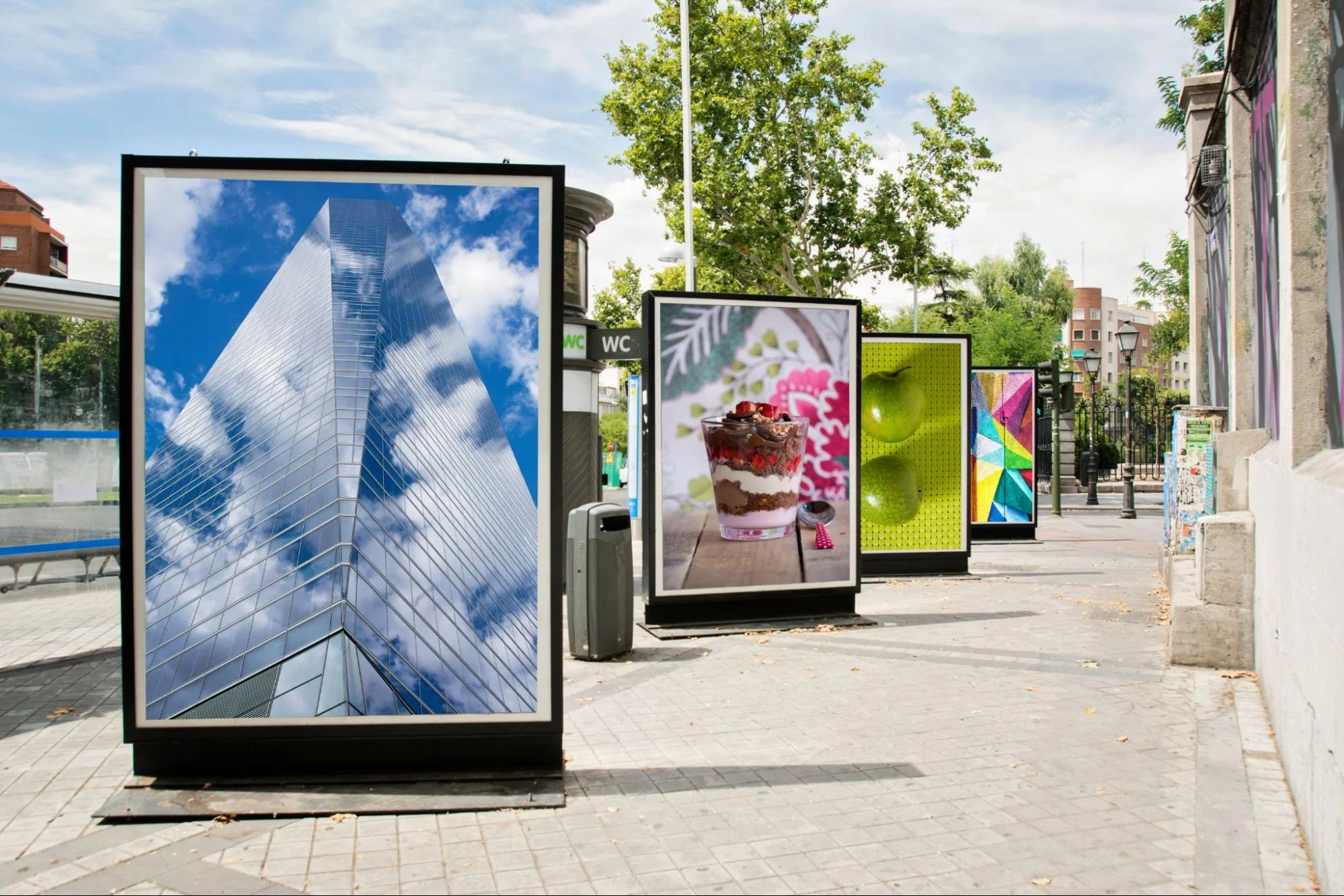The top advertising trends for national brands in 2024

Between emerging technologies, advancements in current tools, and new cultural touch points, every new year brings new trends, especially when it comes to digital advertising trends in 2024.
Some of these trends—like humanized, personalized content—have been gaining traction for a while. Others, including AI and the imminent elimination of third-party cookies, are poised to create rapid change in the near future.
Whether you want to stay ahead of the curve or find ways to maximize your return on investment (ROI) with newer, more efficient technologies, you should keep an eye on the trends listed below when creating your national brand’s strategy.
10 marketing and advertising trends to look out for in 2024
So which marketing and advertising trends will go big this year? Here are the innovations to keep an eye on.
1. Artificial intelligence
2023 was the year that saw the meteoric rise of generative AI, machine learning, and OpenAI’s ChatGPT, making 2024 the year when marketers and advertisers learn how best to harness its power.
Here are some of the ways marketers will put AI to work. One of the top uses will be for optimization in data analytics. In this realm, AI is very fast and efficient, capable of analyzing enormous datasets at hyperspeed—all while discovering trends and insights that human analysts may not necessarily spot immediately.
Generative AI is the other big use case. According to recent research, 73% of marketers are using generative AI as a tool in their toolkit.
Content creation and AI-powered chatbots are popular uses for generative AI. With AI tools, marketers can create product descriptions, marketing emails, brainstorm ideas for advertisements and other types of content, which saves time and money compared to traditional content creation methods. AI can also use large datasets to create hyper-targeted content that speaks directly to specific target audiences.
AI-powered chatbots are proving useful for automation, providing customers with easy access to information and answers to their questions.
All told, AI tools are poised to help marketers stay on top of trends and improve content creation, which in turn helps them boost conversions and increase customer loyalty.
It’s not quite full steam ahead yet, though. Enterprise marketers will need to temper their enthusiasm for AI so that they can be on the lookout for biases. Because of the way generative AI picks up data—by scanning human-created content—it can also pick up the biases within that content, however subtle they may be. Current AI technology is also known to “hallucinate,” which happens when the model creates false information and presents it as facts.
It’s not a new problem. In fact, it’s something that researchers have known about since at least 1988, when the UK Commission for Racial Equality discovered discrimination via software that a British medical school was using to choose applicants for interviews. Today, it’s something for marketers to watch as they experiment with new AI-driven technologies.
2. Personalization and customization

While AI is blossoming at an unprecedented rate, a fundamental need among consumers is taking deeper root. More than ever before, customers want humanized content and marketing campaigns that pack a purposeful punch. In fact, research from McKinsey shows that 71% of consumers expect brands to deliver personalized experiences.
Just look at Nike’s Home campaign for an example of powerful marketing that resonates with consumers. This cross promotion used the word “home,” which was a callback to a meme that began in 1996, when the Euro ‘96 soccer tournament “came back home” to England. Since then, English soccer teams hadn’t enjoyed much success on the European stage—but that changed for the women’s team in 2022.
After the team advanced to the Women’s Euro 2022, Nike swapped out their own brand name for this four-letter word on shirts and banners. When England won, promoters tossed the flags and banners onto the pitch where excited players picked them up, proud to have finally brought such a momentous win home. The promotion resonated loud and clear among proud fans, sparking a wave of demand for more of the shirts and banners.
Ultimately, it’s all about building better customer experiences. Authenticity, personalized messaging, personalized shopping recommendations, custom offers—these are all things that marketers can expand on to create positive experiences that build brand loyalty.
3. Influencer marketing
Influencer marketing has grown from a $1.7 billion industry in 2016 to a $16.4 billion industry in 2022. In 2024, it’s predicted to grow to a $24 billion market.
With influencers, the key is to work with those who can smoothly integrate brand messaging into the existing content that their followers crave. That’s how marketers will create strong connections between their brand and the audiences that are flocking to their chosen influencers.
One great example of this? The America Runs on Munchkins campaign, which features diverse voices like Ice Spice and Ben Affleck standing in as both brand advocates and influencers to promote the brand’s latest drinks.
4. A cookieless future
Concerns about online privacy are nothing new, but recent developments in this area suggest that one of the biggest advertising trends for 2024 will be a shift away from third-party data.
Why? Because the big three browsers—Chrome, Safari, and Firefox—will be blocking or disabling third-party cookies starting in the first quarter of 2024.
And what’s the problem with cookies? Cookies retrieve user information, including details about their logins, items they’ve added to their shopping carts, personalization settings, and other bits of data. On the surface, it sounds like a harmless way to improve the user experience while collecting information that can help marketers understand consumer behavior and create better digital marketing strategies.
However, third-party cookies can also be used to create detailed user profiles containing personal information and demographics details that users may not want to share—e.g., political affiliations, religion, sexuality, and gender.
In light of that, both Mozilla and Apple have implemented tracking protection policies designed to safeguard users against third-party cookies, and Chrome is slowly phasing them out as Google develops new technologies to replace them and maintain privacy.
So what will marketers use instead of third-party data? The answer is first-party data. Marketers can collect this type of information directly from their customer base, subscribers, and site visitors. Every interaction with your website or marketing materials comes with a chance to learn more about who your customers are and the types of experiences they want.
In the next year, the first-party cookie—the type of cookie usually accompanied by a popup reading “We use essential cookies …”—will rise in prominence. These cookies are instrumental in gathering user information as they browse your website—or the websites of your vendors, who should also be using first-party cookies and data to support you. This is the type of data that marketers will leverage for insights into visitors’ experiences, like the types of products they prefer or the pages where they’re most engaged.
5. Cultural touch points

Cultural touch points have been a big part of marketing and ad campaigns for a while. While it isn’t a new trend, the touch points themselves represent new trends and movements for marketers to keep up with each year.
Think about football, and specifically, the Super Bowl, which is an event that is virtually synonymous with American culture. Marketers have long viewed the Super Bowl as an opportunity to push out creative—often hilarious—TV ads because they know that they’ll have a captivated audience. It’s become such a tradition that some people watch the Super Bowl not for the football but for the commercials.
That’s an example of a cultural touch point that marketers can use to their advantage — and 2023 gave us a few more examples, like Taylor Swift’s “Eras” Tour, the “Beyonce Bump,” or the Barbie movie. Some brands took these iconic cultural moments and ran with them.
For example, clothing brands like Gap and Forever 21 have tapped into trends by hopping on the “Barbiecore” bandwagon to produce Barbie-themed products.
And consumers? They want in on the zeitgeist too, which is what makes these partnerships so popular. As with so much in marketing these days, it’s all about creating an experience. When brands can tap into these big cultural moments to create experiences, consumers respond with enthusiasm.
In 2024, expect savvy brands to be on the lookout for these major cultural moments. The coming year will have quite a few: the Olympics, a solar eclipse, the first NASA moon mission in decades, another Ghostbusters movie, and more. In them, there will be opportunities to help consumers take part in the next big movement.
6. Niche communities
Major social media platforms like Facebook, TikTok, and others have been hugely influential for a long time, and they’ll continue to feature prominently. However, they come with one inherent problem: their size.
Meanwhile, the internet is filled with niche platforms and communities where consumers go to escape from the noise and engage in more specialized interests. On Reddit, in private forums and elsewhere, you’ll find smaller communities who unite around all kinds of subjects—gaming, makeup and fashion, cars, electronics, movies and TV, and more.
This is different from a platform like Facebook. During the fourth quarter of 2023, Facebook reached a total of 2.1 billion daily active users. That represents a whole lot of noise—and if you’re an advertiser, it’s easy to get lost in that noise.
Marketers are taking note. In 2024, expect to see the marketing landscape shift toward niche communities, where there are greater opportunities to engage directly with highly targeted audiences who have a deep interest in specific brands and offerings. And paired with the generative AI trend we mentioned earlier, it becomes easier to scale content in a tailored fashion.
7. The continued dominance of video content
Video content on platforms like YouTube, TikTok, Instagram, and even Facebook has been a major marketing tool for a long time. However, for advertising trends in 2024, it won’t be all about promoting a brand or pushing a product through clever and creative video ads. Digital marketers will need to shift focus to instead create videos that connect with audiences on an emotional level.
Consumers don’t want to feel like they’re being manipulated or pushed around, which was one of the reasons why high-pressure sales tactics have gone by the wayside. The same goes for overly produced videos that work hard to sell people on a particular offering. It feels like a hard sales push. In actuality, today’s consumers want to be engaged and entertained—and they want to be able to consume this kind of content quickly and easily. These days, marketers will see a greater return on investment from short-form videos that spin a compelling narrative as opposed to lengthy videos or those with an obvious marketing agenda.
As an example, check out the behind-the-scenes content that the NBA posts on TikTok. Users flock to these short and sweet videos for the authenticity—and to get a look at pro basketball from a rarely viewed angle.
8. Augmented reality

With the rise of the Apple Vision Pro and other virtual reality headsets, both virtual reality (VR) and augmented reality (AR) have been gaining attention for a variety of applications. In marketing, the possibilities for augmented reality in particular are huge.
Why? Because it’s a fantastic way to engage customers and give them a chance to “try before they buy” in an accessible digital space.
To see some examples of augmented reality in action, just look at Sephora’s Virtual Artist or Ray-Ban’s Frame Advisor Technology. In both of these examples, users can use their phone cameras to try on various products.
Not only is it fun and engaging, but it’s also instrumental in helping consumers make purchase decisions. Where once they may have been unsure about a particular shade or set of sunglasses, this technology helps customers make a more informed decision.
That’s one way to use AR in marketing, but forward-looking marketers are looking at other ways to implement it too. AR gives you the functionality to deliver 3D product visualizations for everything from household gadgets to cars. Brands can also leverage gamification by creating AR games that engage while offering discounts or other rewards.
On social media platforms like Snapchat and TikTok, marketers can create branded AR filters and effects for users to enjoy. Here’s one from Disney Plus that lets you transform yourself into Ahsoka from Star Wars on Snapchat.
9. Social commerce
Much of this year’s digital marketing trends center around one theme: creating easy ways for customers to find, research, and purchase products. And for that reason, it’s expected that social commerce—shoppable posts and profiles optimized for sales—will become much more popular in 2024.
This will help solve a big problem that both brands and consumers face, which is the accessibility of trending products. Right now, when consumers see something that interests them, it often takes multiple steps to track down the brand and website that sells it, go through the signup process, and make the purchase. This can be a difficult process for customers—and for brands, it means fewer overall conversions as customers drift away at various stages of this journey—or find knockoffs while they search for your product.
Social commerce can help solve these issues. Consumers can spot trendy new products and make the purchase immediately—no need to browse away from the post or the platform. It creates an easy, seamless experience for customers, and brands leveraging this type of strategy will be able to boost conversions.
Anthropologie is a great example of a brand who is doing both well. If you visit their Instagram page, you can get a look at the latest fashion trends—and follow the links in their bio to buy them. One of those links takes you to the Anthropologie LikeShop page, where you can browse shoppable posts to your heart’s content.
TikTok is also currently testing a new feature to make posts shoppable. If this feature goes live, it would make all TikTok posts shoppable. It works by identifying items in videos, then prompting users to “find similar items on TikTok Shop.”
10. Local marketing
In the early days of search engine optimization and digital marketing, marketers focused on casting a wide net—and with that, searchers could discover global brands and products from around the world.
Today, however, shopper’s tastes have shifted. The pandemic drove demand for the ability to shop online and get same-day delivery—and this trend has continued, with growing numbers of people using the internet to find products close to home so that they can make a same-day local purchase.
For marketers, this means a growing reliance on tools that can help them place brands and products in front of local audiences.
Yelp for Brands is one such tool. It’s designed to help marketers take national marketing campaigns to the local level. With Yelp for Brands, you can create custom store pages for individual locations, making it easier for shoppers to find your brand in their region.
You can also use it to deliver targeted, personalized ads to different customer segments at every stage of the consumer’s buying cycle, and it offers robust analytics so that you can measure your ROI and ensure that your marketing efforts are meeting the goals that you’ve set forth.
Going forward, tools and platforms such as these will be absolutely essential for multi-location enterprises as the primary way to make national or international brands more accessible to local communities.
Make your brand accessible with Yelp for Brands
Today’s marketing trends and advancements revolve around creating the best customer experience possible. That means making it easy for customers to find information, leveraging new technologies to build engagement, and finding creative new ways to put your brand in front of highly targeted local audiences.
Yelp for Brands is here to help you take the top advertising trends for 2024 and turn them into a digital marketing strategy that converts. To learn more, book an appointment with a Yelp for Brands expert to discover advanced solutions for your business.